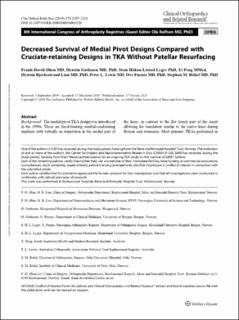| dc.description.abstract | Background
The medial pivot TKA design was introduced in the 1990s. These are fixed-bearing, medial-conforming implants with virtually no translation in the medial part of the knee, in contrast to the flat lateral part of the insert allowing for translation similar to the native knee during flexion and extension. Most primary TKAs performed in Norway and Australia are cruciate-retaining. All of the medial pivot implants in our study are cruciate-sacrificing but without a post-cam mechanism. The medial pivot implant design was developed to more closely mimic native knee motion, in the hope of improving function, and not primarily as a more constrained knee for difficult cases. In the past 10 to 12 years, a second-generation medial-pivot design has emerged, but there are no larger registry studies on the survival of these implants. Both cruciate-retaining and medial pivot designs are reported in the Australian and Norwegian registries, allowing for large-scale, comparative survivorship studies.
Questions/purposes
(1) Is there any difference in survival between the medial pivot design and the three most commonly used cruciate-retaining TKA designs? (2) Is there any difference in survival among the different medial pivot implant designs? (3) What are the main indications for revision of medial pivot TKAs?
Methods
Registry data from the Australian Orthopaedic Association National Joint Replacement Registry and Norwegian Arthroplasty Register from 2005 until the end of 2017 were used to compare the five different brands of medial pivot TKA designs (total primary TKAs assessed: 6310). In Australia, the study group of medial pivot implants represented 9% (6012 of 72,477) of the total number of cemented/hybrid TKAs without patellar resurfacing; 345 had cementless femoral components. In Norway, the study group represented 1% (298 of 47,820) of the total number of TKAs with cemented tibias without patellar resurfacing; all had cemented femoral components. The control group consisted of the three most commonly used cruciate-retaining TKA designs (n = 70,870; Australia n = 54,554; Norway n = 16,316). All TKAs used a fixed-bearing, cemented tibial component and did not involve patella resurfacing. Kaplan-Meier survival analysis was assessed to estimate survivorship. We compared the groups by calculating the hazard ratios (HR) using Cox regression adjusted for age, gender and preoperative diagnosis with 95% CI. To answer our third question, we calculated the percentage of each revision indication from the total number of revisions in each group, and used a Cox regression analysis to compare revision causes and HRs. Analyses were performed separately by each registry. Accounting for competing risks (Fine and Gray) did not alter our findings [12].
Results
After controlling for potential confounding variables such as gender, age and preoperative diagnosis, we found an increased revision risk for the medial pivot compared with cruciate-retaining TKA designs in Australia (HR 1.4 [95% CI 1.2 to 1.7]; p < 0.001), but not in Norway (HR 1.5 [95% CI 0.9 to 2.4]; p = 0.1). Two brands of the medial pivot design reported to the AOANJRR showed an increased risk of revision compared with cruciate-retaining designs: the Advance® II MP (HR 1.7 [95% CI 1.2 to 2.6]; p = 0.004) and the GMK® Sphere (HR 2.0 [95% CI 1.5 to 2.6]; p < 0.001), whereas the MRK™ (HR 0.7 [95% CI 0.4 to 1.5]; p = 0.4), the Evolution® MP (HR 1.4 [95% CI 1.0 to 1.9]; p = 0.06) and the SAIPH® (HR 0.9 [95% CI 0.5 to 1.5]; p = 0.7) showed no difference. The most common reasons for revision of medial pivot implants in Australia were infection (27%), pain alone (19%), patellar erosion (13%), loosening/lysis (12%); in Norway the primary indications were loosening/lysis (28%), instability (28%), malalignment (11%) and pain alone (11%).
Conclusions
The medial pivot TKA design as a group had a higher revision rate than cruciate-retaining fixed-bearing controls in TKA performed without patellar component resurfacing. By brand, the Advance II MP and the GMK Sphere had inferior survivorship, whereas the MRK, the SAIPH and the Evolution MP had no differences in survivorship compared with cruciate-retaining controls. In Australia, TKAs with the medial pivot design without patella resurfacing had a higher rate of revisions for instability, malalignment, and patella erosion. In Norway, there was an increased risk of revision for lysis and loosening compared with the cruciate-retaining design. Several of these implants had short follow-up in this study. Further registry studies with longer follow up are therefore necessary.
Level of Evidence
Level III, therapeutic study. | en_US |

